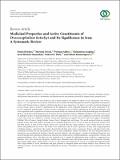| dc.description.abstract | Objectives. Dracocephalum has over 60 species and is found mainly in the temperate regions of Asia and Europe. One of these species, i.e., Dracocephalum kotschyi Boiss, is known to have a number of medicinal properties and active ingredients in many parts of the world. Despite being an endemic wild-flowering plant of great importance, the plant is currently considered endangered in Iran. Besides, there is paucity of information on the significance of the medicinal properties and active constituents of D. kotschyi among the Iranian people. On that account a systematic review of studies reporting on the medicinal properties and active ingredients and its significance to human and animal health was conducted and the existing knowledge gaps were identified. Methods. The Preferred Reporting Items for Systematic Reviews and Meta-Analyses (PRISMA) guidelines were used in the search for published articles on medicinal properties and active ingredients of D. kotschyi and its significance on humans and animals in Iran. The search was confined to scientific articles from repositories of popular data bases and search engines among them PubMed, Web of Science, Google Scholar, Science Direct, SpringerLink, and Scopus. The search narrowed down on scientific journals, books, and book chapters focusing on the medicinal properties of D. kotschyi in Iran for the period between 1970 and 2018. Results. A total of 1158 scientific articles were sourced from the various databases, out of which 38 met the search criteria and qualified for this review. The studies were conducted in only 9 of the 31 provinces of Iran, with a large proportion in Isfahan province, central Iran. The studies showed that all plant parts (roots, aerial parts, flowers, and leaves) had active constituents. Essential oils and aerial plant parts were the main components studied. Nevertheless, the most frequently reported constituents were xanthomicrol, limonene, luteolin, geranial, apigenin, and calycopterin. A number of medicinal properties were reported among them antioxidant, antibacterial, anticancerous, antinociceptive, antihyperlipidemic, antispasmodic, cytotoxic, and immunomodulatory effects. The plant was also reported to be a remedy for inflammatory pain, headaches, congestion, liver disorders, ulcer, fever, renal pain, dyspepsia, stomach ache, abdominal pain, joints pains, muscle spasm, congestion, bloating, and wound healing effects, among others. Conclusion. This review has shown that D. kotschyi is an important medicinal plant with a large number of active constituents and great potential to safeguard human and animal health in Iran. However, over utilization of the D. kotschyi plant is already endangering its existence. Nevertheless, more studies need be conducted across the country. | en_US |

